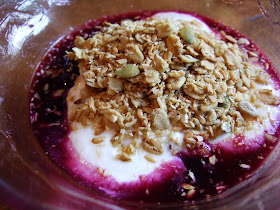The other day I roasted a mallard duck (which I'd found at a good price at our local butcher, I hasten to add). Mallards are quite small so there was only enough for 2 plus a carcass with a fair bit of meat on it for stock. I left it overnight in the AGA and the result was superb so I started thinking of dishes to set it off.
Beetroot risotto, inspired by a recipe from
The Larder Lout, one of the students who collaborated on my recent
student cookbook, emerged at the top of the list but I hadn't got any beetroot and had run out of risotto rice. I also fancied some horseradish in it and a dollop of crème fraiche so ended up spending over a fiver to make a dish for two - not so frugal after all.
It made me think how relative frugality is. If I'd already had most of these ingredients in the fridge or storecupboard - apart from the beets - it wouldn't have been expensive. Good cooks tend to have well-stocked storecupboards. Less well-off and less knowledgeable ones like students don't so are not generally able to make such interesting and complex dishes. The knack of frugal cooking - which I occasionally forget in my enthusiasm - is to be able to make a delicious dish from not a lot.
Anyway here's the recipe, for those of you who do have a well-stocked larder and a spare mallard (or other duck) carcass going begging. (Apologies for lack of picture. I was experimenting with new light settings - unsuccessfully!)
Duck and beetroot risotto
Serves 2
3 tbsp duck fat or olive oil
1 small red or other onion, finely chopped
a sprig of fresh thyme (optional)
150g arborio or other risotto rice
125ml red wine
750 ml hot duck (or other game) stock
half a bunch of beetroot (about 2 medium-sized beets, peeled and grated)*
25g parmesan cheese, grated
1 tbsp grated horseradish and 1 heaped tbsp creme fraiche or 2 tbsp creamed horseradish
leftover duck meat, cut into short lengths
a handful of the beet leaves, washed and shredded
salt and freshly ground black pepper
Heat 2 tablespoons of the duck fat in a large sauté pan or saucepan and cook the onion and thyme over a gentle heat until the onion is soft. Season with salt and pepper, increase the temperature and stir in the rice. Stir for a couple of minutes before adding the wine.
When the rice has absorbed the wine, add beetroot and stir for few seconds then add a ladle of the hot stock. Continue to stir regularly, adding a ladle of stock each time the rice has absorbed the previous batch. After 17 minutes or so taste the risotto. It should be almost cooked with just a little bite remaining. Cook for a minute or two longer if not. Remove the thyme sprig and stir in in the parmesan, horseradish and crème fraîche. Add a final ladle of stock, turn off the heat, cover the pan and leave for a few minutes.
Briefly fry the duck pieces in the remaining duck fat until crisp. Remove from the pan with a slotted spoon and drain them on kitchen paper. Wilt the greens in the same pan, adding a splash of water if necessary. Season them well with salt and pepper.
Stir the risotto again and dish up in warm bowls, topping with the stir-fried greens and the crisp shards of duck.
* Grating beetroot, if you don't already know this, is messy. I suggest acquiring some of those cheap, disposable plastic gloves to do it! (Another expense - but they are useful for other things!)
How big a store-cupboard do you have - in terms of range of ingredients rather than physical size? And, another issue, if you have an extensive one, do you get round to using all the ingredients before they go out of date?
 How long should a blog last? It's a question, I guess, that more and more bloggers will be asking themselves over the next year or so. This one has lasted just over 21 months which isn't bad but I feel its time has come.
How long should a blog last? It's a question, I guess, that more and more bloggers will be asking themselves over the next year or so. This one has lasted just over 21 months which isn't bad but I feel its time has come.





































